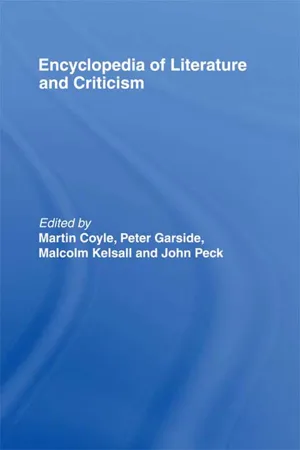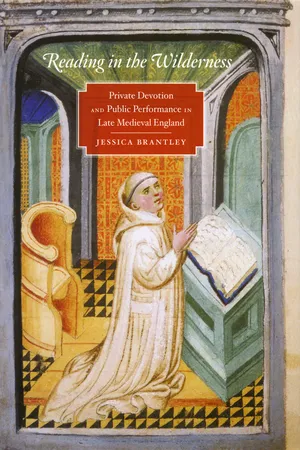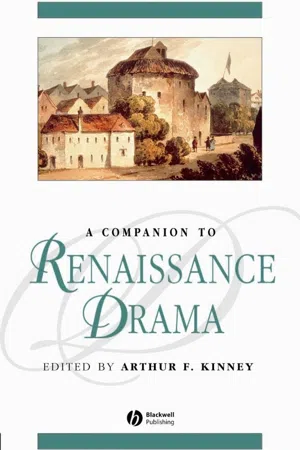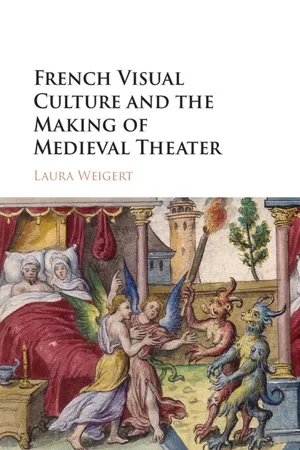Literature
Medieval Drama
Medieval drama refers to theatrical performances and plays that were popular in Europe during the Middle Ages, roughly from the 5th to the 15th century. These dramas often depicted religious themes and were performed as part of religious festivals and ceremonies. They played a significant role in the cultural and religious life of medieval society, and helped convey religious teachings to the largely illiterate population.
Written by Perlego with AI-assistance
Related key terms
1 of 5
7 Key excerpts on "Medieval Drama"
- eBook - ePub
- Peter Happe(Author)
- 2018(Publication Date)
- Routledge(Publisher)
Part IThe Medieval Drama
Passage contains an image
Chapter 3
Worship, Instruction and Entertainment: Liturgical Drama
Since the bulk of English drama before 1500 is religious, and since a very considerable portion of that surviving from the sixteenth century is either specifically didactic or substantially influenced by religious matters, we shall attempt in this chapter to give an account of the religious contexts in which the plays were written and performed. This will include a consideration of the liturgical drama, which is closely linked.In describing or contemplating Medieval Drama we ought not to impose distorting modern norms upon a varied corpus of plays, neither in terms of time, nor in terms of types of play, nor in terms of what the twentieth century has come to see as drama. For us the drama takes place on a stage, or on television, or on film or on radio. We may experience drama in a theatre with a proscenium arch, or in an arena, or in a village hall. Today a large part of the appreciation and understanding of drama also takes place by studying the texts of drama in printed books. All of these modes may help us to come closer to the Medieval Drama, but they all contain obstacles as well.Life in medieval times was much more orientated towards religion, both in outward forms like people’s occupations and also with regard to the inner life. There was a very strong sense of human impermanence, and religion was seen as a way of meeting many difficulties and misfortunes. Instability in society, and the proximity of life-threatening experiences such as the plague or childbirth are constant themes of preaching as well as of the various forms of consolation and instruction which the Church developed. On the other hand, worship also comprised joy and celebration and gave cause for hope. The work of the Church was concerned with both fear and the hope which transcended it. Thus to regard the religious content of the early plays as being about moral instruction alone is to narrow its scope too far. - eBook - ePub
- Martin Coyle, Peter Garside, Malcolm Kelsall, John Peck(Authors)
- 2002(Publication Date)
- Routledge(Publisher)
Rooted in the community and arising from key events in the social, spiritual and seasonal cycle, medieval plays depend for their rich intensity on that close association with the rhythms and moods of demotic life and the vigour and verve of popular speech also found in Chaucer, Langland and Skelton. Highly pictorial, relying on presentational rather than representational techniques, exhibiting a range of registers from formal hymns of adoration to satirical subversions of the temporal hierarchy, the drama of the Middle Ages is not in danger of falling out of fashion. It testifies to a firm belief that drama can render sharply and graphically abstract concept and didactic moral, and offer to reader and spectator a theatrical replication of ‘God’s plenty’ which exalts vitality and variety.What the twenty-first century holds is unclear: one suspects that for most people English drama will still begin with Shakespeare. Even the finest critics of today and tomorrow can probably never make the Medieval Drama familiar or accessible to the man in the street. Yet it cannot be denied that John R. Elliott Jr.’s words are even truer at the present time than when he wrote them in 1969:These plays have ceased to be mere historical curiosities and have become for us works of art, as impressive in their scope and intensity as the greatest products of medieval literature.Further Reading
- Bevington, David (ed.) (1975) Medieval Drama , Houghton Mifflin, Boston
- Happé, Peter (ed.) (1975) English Mystery Plays: A Selection , Penguin, Harmondsworth
- Hardison, O.B., Jr. (1965) Christian Rite and Christian Drama in the Middle Ages , Johns Hopkins University Press, Baltimore
- Kahrl, Stanley J. (1974) Traditions of English Medieval Drama , Hutchinson, London
- Kolve, V.A. (1966) The Play Called Corpus Christi , Edward Arnold, London
- Potter, Robert (1975) The English Morality Play: Origins, History and Influence of a Dramatic Tradition , Routledge & Kegan Paul, London
- Southern, Richard (1957) The Medieval Theatre in the Round , Faber & Faber, London
- Taylor, Jerome and Nelson, Alan H. (eds) (1972) Medieval English Drama: Essays Critical and Contextual , University of Chicago Press, Chicago
- Tydeman, William (1978) The Theatre in the Middle Ages: Western European Stage Conditions c. 800–1576
- eBook - PDF
Western Drama through the Ages
A Student Reference Guide [2 volumes]
- Kimball King(Author)
- 2007(Publication Date)
- Greenwood(Publisher)
EARLY BIBLICAL DRAMA IN EUROPE The official relationship between Christianity and drama has, however, often been strained. With the rise of Roman Christendom came the decline of theater, a decline St. Augustine noted with approval in 400 A. D. Misgivings about the deceptiveness of acting and disapproval of actors’ lifestyles contributed to the virtual eradication of formal theater in Christian Europe by the sixth century. Ironically, however, the Church itself celebrated Christianity’s dramatic elements in increasingly complex ways, enhancing celebrations of the Eucharist by adding antiphonal exchanges and having priests adopt the roles of characters in accounts of Jesus’s resurrection from the dead. Over time, as more scenes were added, liturgical Latin gave way to local languages and the dramatic services’ popularity grew, the action moved from the cathedral choirs to the naves. By the early thirteenth century, many productions had moved outdoors to accommodate crowds. In 1210, Pope Innocent III ordered them out of the church entirely, and soon trade guilds began taking over the plays’ produc- tion and moving them to community gathering places, sometimes on large wagons serving as stages. Although they added secular, comical features; local, anachronistic elements; and regional expressions, guild members retained the approval of local Roman Catholic clergy and continued to use the plays to illustrate events from the Bible and instruct audiences in Church doctrine and practice. In their own day, these biblical scenes were often called ‘‘miracles,’’ although most drama historians today reserve that term for discussing plays about saints’ lives and use the term ‘‘mysteries’’ for dramas based directly on the Bible. The term’s significance lies not so much in its relation to the plays’ subject matter as it does their roots in the trade guilds. ‘‘Mystery’’ is derived from the French ‘‘mystere’’ or ‘‘metier,’’ words associated with trade guilds. - eBook - PDF
Reading in the Wilderness
Private Devotion and Public Performance in Late Medieval England
- Jessica Brantley(Author)
- 2008(Publication Date)
- University of Chicago Press(Publisher)
8 But the material texts of Medieval Drama attest most immediately to contemporary reading practices, as well as to more distant performative events. The performative reading of dramatic im-agetexts in the Carthusian miscellany Additional 37049 relies upon the broader context established by medieval plays for reading. This category of medieval closet drama—play scripts, privately read—includes those dramatic texts that, in spite of clear marks of performance practice, were also sometimes probably studied in solitude, and also those that were so clearly designed for reading that it is possible to imagine that they were never staged at all. d r a m at i c t e x t s , l y r i c v o i c e s , a n d p r i vat e r e a d e r s The “Towneley lyric” discussed in chapter 1 stages lines that are elsewhere part of a dramatic text specifically for private reading (pl. 1). As I have ar-gued, the poem turns on reproducing the sights and sounds of the Passion in a way that links this manuscript page with the experience of theatrical spectacle. But the poem presents a codicological conundrum, as well as a generic one; it begins on fol. 67v, but ends on fol. 45v, where it is entirely unillustrated. It is difficult to imagine what could have produced this state of affairs—why a scribe would begin a text on one folio, and finish it on one twenty pages earlier. Possibly the two texts were conceived separately, and were copied from different exemplars. It seems more likely (since they ap-pear whole in the two other manuscripts that contain them) that their sep-aration reflects the scribe’s adjustment to his limited space, and shows the Theatrical Performances in Monastic Reading * 271 meandering and mobile ways in which readers were expected to approach this diffuse collection of scattered bits and pieces. But it is significant that the two folios in question bracket the Desert of Religion. The text of the long poem actually ends on fol. 66v, but the subjects and themes of fol. - eBook - PDF
- Arthur F. Kinney(Author)
- 2008(Publication Date)
- Wiley-Blackwell(Publisher)
Richard Beadle. Cambridge: Cambridge University Press. Tydeman, William (1994). “An introduction to medieval English theatre.” In The Cambridge Companion to Medieval English Theatre , ed. Richard Beadle. Cambridge: Cambridge University Press. Wager, William (1967). The Longer Thou Livest, and Enough is as Good as a Feast , ed. R. Mark Benbow. Lincoln: University of Nebraska Press. Walker, Greg (1995). “A broken reed?: Early drama records, politics, and the old historicism.” Medieval English Theatre 17, 42–51. Wasson, John (1982). “The morality play: ancestor of Elizabethan drama?” In The Drama of the Middle Ages: Comparative and Critical Essays , eds Clifford Davidson, C. J. Giankaris, and John H. Stroupe. New York: AMS Press. Wasson, John (1997). “The English church as theatrical space.” In A New History of Early English Drama , eds John D. Cox and David Scott Kastan. New York: Columbia University Press. Weimann, Robert (1978). Shakespeare and the Popular Tradition in the Theater , ed. Robert Schwartz. Baltimore and London: Johns Hopkins University Press. Wickham, Glynne (1980; first pub. 1959–72). Early English Stages 1300–1600 . 3 vols. London: Routledge and Kegan Paul. Wilson, F. P. (1969). The English Drama 1485–1585 , ed. G. K. Hunter. Oxford: Clarendon Press. Young, Karl (1933). The Drama of the Medieval Church . Oxford: Clarendon Press. 256 Raphael Falco 18 The Academic Drama Robert S. Knapp Francis Meres’ famous list of the best English authors has little critical value beyond establishing what minimally well-educated gentlemen could have known about their literary heritage in 1598, yet a telling peculiarity in its order of names helps us situate the academic drama. Modern scholarship has tended to make Tudor academic drama into a niche topic, segregated by its dominant language (Latin) and its ordinary venue (the college hall) from what is normally taught and studied as constituting the English dramatic tradition. - Laura Weigert(Author)
- 2015(Publication Date)
- Cambridge University Press(Publisher)
15 The most detailed study of processional drama also concludes that the public display of Christian themes served a devotional function in late medieval cities. 16 late medieval visual arts This book comes to several related conclusions that undercut these resilient features of the ongoing discussion about late medieval “art” and “theater.” First, rather than making up two ontologically distinct media, pictures of various kinds were considered to be in many ways homologous to visual art that involved human beings. Second, the primary goal of these representa- tional forms was not to encourage audiences to identify in them an approxi- mation of their own lived environment; rather, their makers and viewers recognized and promoted the distance from it such forms achieved. 17 INTRODUCTION: FROM THEATRICALITY TO THEATER 5 The appreciation of this fictionality was vital to an aesthetic experience that engaged a community of viewers, removed from the devotional function that representations of specifically sacred subject matter might have fulfilled for a particular individual. Contemporary descriptions of the late medieval visual arts set me on the path to the broader investigation that led to these conclusions. I noticed initially that authors of various types of texts assert the advantage of the visual dimension that characterizes the audience’s experience of a live performance, rather than their appreciation of the spoken or written word. The Grandes Chroniques assert that the way Godfrey of Bouillon’s conquest of Jerusalem was enacted and seen during Charles V’s banquet was far superior to what could be captured in words. 18 In his advice to the organizers of large- scale urban productions, Jean Bouchet explicitly distinguishes the transmission of heard information from that which is seen.- eBook - PDF
- Jeffrey L. Forgeng, Will Mclean(Authors)
- 2008(Publication Date)
- Greenwood(Publisher)
Addi- tional legal material was added by a later owner in the fourteenth cen- tury. Another popular genre was the collection of moral tales, stories with edifying lessons derived from the Bible, the lives of saints, fables, and Entertainments 209 classical sources. Medieval readers of such works might be familiar with the characters of Æneas and Helen of Troy even if they never read Virgil or Homer. A well-to-do French townsman of Chaucer’s day known as the Ménagier de Paris composed an instructional treatise for his daughters in which he cited the Bible, the lives of the saints, and the works of St. Augustine, St. Gregory, St. Jerome, the classical historians Josephus and Livy, and Cicero, as well as such medieval works as Romance of the Rose and Petrarch’s tale of Patient Griselda—many of which he probably knew only in excerpted form. Music Music was another universal form of entertainment. Some of it was pro- vided by professional musicians, who were often hired by the aristocracy and rich townsfolk. Ordinary people could scarcely afford such a luxury; although they might occasionally have the opportunity to hear traveling musicians, they had to create most of their music themselves. It was common for people to sing for their own entertainment, sometimes as part of holi- day revelry, sometimes during work to make the labor go more easily. The subjects of songs were diverse: there were love songs, drinking songs, and religious songs, songs about historical events and current politics, satirical songs about money or sex, and even nonsense songs. Froissart relates how the leading men in England entertained themselves with music while wait- ing to encounter the Spanish fleet at the battle of Winchelsea in 1350: “The king . . . ordered his minstrels to play before him a German dance which Sir John Chandos had lately introduced.
Index pages curate the most relevant extracts from our library of academic textbooks. They’ve been created using an in-house natural language model (NLM), each adding context and meaning to key research topics.






